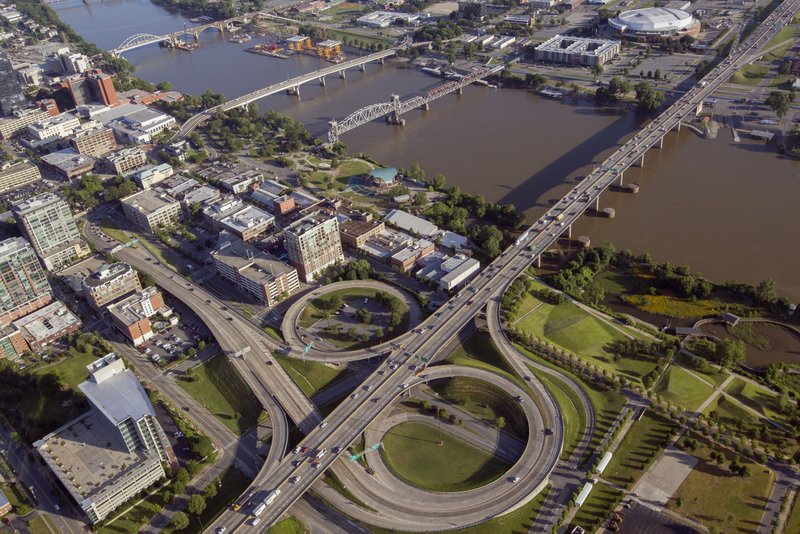Progress to build Arkansas' biggest civil engineering project is being slowed by its potential impact on the capital city's oldest neighborhood.
Taking into account the possible repercussions the $631.7 million project to overhaul the Interstate 30 corridor through downtown Little Rock and North Little Rock might have on the MacArthur Park Historic District has significantly delayed the release of an environmental review of the project, the Arkansas Department of Transportation acknowledged last week.
In November, state highway officials said the federally mandated review would be completed as soon as this month.
"I've been expecting it any day now," Little Rock Mayor Mark Stodola said Friday.
But on the same day, a department spokesman said the review wouldn't be available until April ahead of a public hearing that is scheduled to be held in May to discuss it.
He cited issues involving the potential effects on the 50-square-block district that was the city's first neighborhood and includes several buildings that date to the 1840s and 1860s.
The neighborhood also is home to the Little Rock Arsenal.
The birthplace of Gen. Douglas MacArthur now houses the Museum of Arkansas Military History.
The delay has pushed back the anticipated start of construction of what is called 30 Crossing from early 2019 to the middle of the same year.
But agency spokesman Danny Straessle said the project remains on track for completion in 2023.
Patricia Blick, executive director of the Quapaw Quarter Association, said she welcomed the additional scrutiny although her organization hasn't been party to the discussions of potential changes to the project that are being considered.
The association promotes preservation in downtown Little Rock.
Its offices are housed in Curran Hall, which is on East Capitol Avenue -- the northern boundary of the historic district. The example of Greek Revival architecture was built in 1842.
Blick said she believed department officials were taking potential neighborhood impacts "very seriously."
Blick's organization doesn't oppose the project but is on record preferring an alternative that would limit widening the 6.7-mile corridor between Interstate 530 in Little Rock and Interstate 40 in North Little Rock to eight lanes. It is now a six-lane thoroughfare.
Department analysis of data developed for the project disclosed last month indicate the route would better handle traffic now and in the future using 10 lanes.
The Federal Highway Administration will review the data before making the final decision.
The latest design for the 10-lane alternative features four lanes that will be more like city streets, with ramps to lower speeds, narrower lanes, traffic signals and other features to allow traffic moving on or off I-30 to safely interact with pedestrians and other noninterstate traffic.
The 10-lane alternative has been referred to as a mix of six main through lanes with four collector-distributor lanes.
The latter are separated by a wall from the main lanes, have slower speeds and allow traffic traveling between Little Rock and North Little Rock to cross the bridge without entering the main interstate lanes.
A new interchange for downtown Little Rock is the source of concern for Blick's organization. It would disperse traffic throughout the city's downtown street grid.
But increased traffic within the historic district, she said, could detract from the "residential character" of the area.
The department already has backed off plans to eliminate on-street parking on East Sixth Street to help push more traffic onto the street, which is mostly a one-way route west from I-30.
The agency also is contemplating some additional changes to the proposed interchange to take more traffic off Capitol Avenue, according to agency officials.
That information will be available to agency partners on the project within the next several weeks.
Stodola said although he wasn't aware of the delay, he knew they were working on the issue of downtown traffic patterns.
"There's no taking of any property so the only issue is when you mitigate the traffic by spreading it throughout the grid. Is there any detrimental impact?" he said.
"My take, based on being involved in preservation for 40 years, is that there's really no detrimental impact.
"You may be increasing traffic a little bit, but Capitol Avenue has virtually no traffic on the historic part now."
The mayor also said the new interchange will "offset" what many consider the detrimental impacts the existing interchange at Cantrell Road and I-30 have now on important downtown areas, including historical ones.
He said the new interchange "minimizes traffic on Second Street" that now goes by the Historic Arkansas Museum, which is built around a pre-Civil War neighborhood that includes the oldest home still standing in Little Rock and the site where William Woodruff once printed the Arkansas Gazette.
The project also will eliminate use of the historic Hangar Hill neighborhood on the east side of I-30 as a cut-through for motorists going east on Interstate 630.
During peak afternoon commutes, motorists use a residential street in the neighborhood to bypass heavy traffic on I-30 leading to the bridge over the Arkansas River.
"I know there's a sensitivity to the issue," Stodola said.
"But there's some counterbalancing benefits the [proposed interchange] has. It will eliminate the cut-through on that, which I think is a benefit to the historic Hangar Hill."
A Section on 01/29/2018
